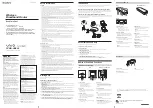
A-1
Appendix A: Troubleshooting
Check the following items before you contact local Technical Support.
1.
If wireless clients cannot access the network, check the following:
• Be sure the access point and the wireless clients are configured with the same
Service Set ID (SSID).
• If authentication or encryption are enabled, ensure that the wireless clients are
properly configured with the appropriate authentication or encryption keys.
• If authentication is being performed through a RADIUS server, ensure that the
clients are properly configured on the RADIUS server.
• If authentication is being performed through IEEE 802.1X, be sure the
wireless users have installed and properly configured 802.1X client software.
• If MAC address filtering is enabled, be sure the client’s address is included in
the local filtering database or on the RADIUS server database.
• If the wireless clients are roaming between access points, make sure that all
the access points and wireless devices in the Extended Service Set (ESS) are
configured to the same SSID, and authentication method.
2.
If the access point cannot be configured using the Telnet, a web browser, or
SNMP software:
• Be sure to have configured the access point with a valid IP address, subnet
mask and default gateway.
• If VLANs are enabled on the access point, the management station should be
configured to send tagged frames with a VLAN ID that matches the access
point’s management VLAN (default VLAN 1, page 6-17). However, to manage
the access point from a wireless client, the AP Management Filter should be
disabled (page 6-17).
• Check that you have a valid network connection to the access point and that
the Ethernet port or the wireless interface that you are using has not been
disabled.
• If you are connecting to the access point through the wired Ethernet interface,
check the network cabling between the management station and the access
point. If you are connecting to access point from a wireless client, ensure that
you have a valid connection to the access point.
• If you cannot connect using Telnet, you may have exceeded the maximum
number of concurrent Telnet sessions permitted (i.e, four sessions). Try
connecting again at a later time.
Содержание AWAP02O-86
Страница 1: ...Enterprise Outdoor 802 11 a b g Access Point USER MANUAL...
Страница 2: ...User Guide 2 4 GHz 5 GHz Wireless Outdoor Access Point IEEE 802 11g and 802 11a Dual band Access Point...
Страница 13: ...Chapter 2 3 Hardware Installation...
Страница 22: ...Initial Configuration 5 4 5 The home page displays the Main Menu...
Страница 29: ...System Configuration 6 8 6...
















































